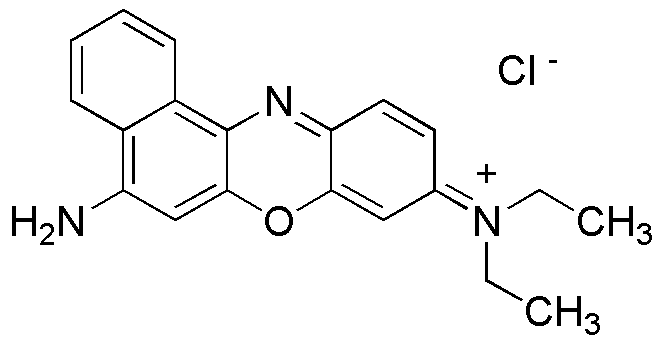Nile Blue Chloride is widely utilized in research focused on:
- Cell Staining: This compound is commonly used as a fluorescent dye for staining cells in biological research, allowing scientists to visualize cellular structures and processes under a microscope.
- Histological Studies: In histology, Nile Blue Chloride helps in differentiating between various tissue types, enhancing the understanding of tissue morphology and pathology.
- Drug Delivery Systems: Researchers explore its potential in drug delivery applications, where its fluorescent properties can help track the distribution and release of therapeutic agents in vivo.
- Environmental Monitoring: The compound is used in studies assessing the presence of pollutants in water bodies, providing a means to visualize and quantify contaminants.
- Nanotechnology: In the field of nanotechnology, Nile Blue Chloride is utilized for labeling nanoparticles, facilitating the study of their interactions with biological systems.
General Information
Properties
Safety and Regulations
Applications
Nile Blue Chloride is widely utilized in research focused on:
- Cell Staining: This compound is commonly used as a fluorescent dye for staining cells in biological research, allowing scientists to visualize cellular structures and processes under a microscope.
- Histological Studies: In histology, Nile Blue Chloride helps in differentiating between various tissue types, enhancing the understanding of tissue morphology and pathology.
- Drug Delivery Systems: Researchers explore its potential in drug delivery applications, where its fluorescent properties can help track the distribution and release of therapeutic agents in vivo.
- Environmental Monitoring: The compound is used in studies assessing the presence of pollutants in water bodies, providing a means to visualize and quantify contaminants.
- Nanotechnology: In the field of nanotechnology, Nile Blue Chloride is utilized for labeling nanoparticles, facilitating the study of their interactions with biological systems.
Documents
Safety Data Sheets (SDS)
The SDS provides comprehensive safety information on handling, storage, and disposal of the product.
Product Specification (PS)
The PS provides a comprehensive breakdown of the product’s properties, including chemical composition, physical state, purity, and storage requirements. It also details acceptable quality ranges and the product's intended applications.
Certificates of Analysis (COA)
Search for Certificates of Analysis (COA) by entering the products Lot Number. Lot and Batch Numbers can be found on a product’s label following the words ‘Lot’ or ‘Batch’.
Número de catálogo
Número de lote/lote
Certificates Of Origin (COO)
This COO confirms the country where the product was manufactured, and also details the materials and components used in it and whether it is derived from natural, synthetic, or other specific sources. This certificate may be required for customs, trade, and regulatory compliance.
Número de catálogo
Número de lote/lote
Safety Data Sheets (SDS)
The SDS provides comprehensive safety information on handling, storage, and disposal of the product.
DownloadProduct Specification (PS)
The PS provides a comprehensive breakdown of the product’s properties, including chemical composition, physical state, purity, and storage requirements. It also details acceptable quality ranges and the product's intended applications.
DownloadCertificates of Analysis (COA)
Search for Certificates of Analysis (COA) by entering the products Lot Number. Lot and Batch Numbers can be found on a product’s label following the words ‘Lot’ or ‘Batch’.
Número de catálogo
Número de lote/lote
Certificates Of Origin (COO)
This COO confirms the country where the product was manufactured, and also details the materials and components used in it and whether it is derived from natural, synthetic, or other specific sources. This certificate may be required for customs, trade, and regulatory compliance.


